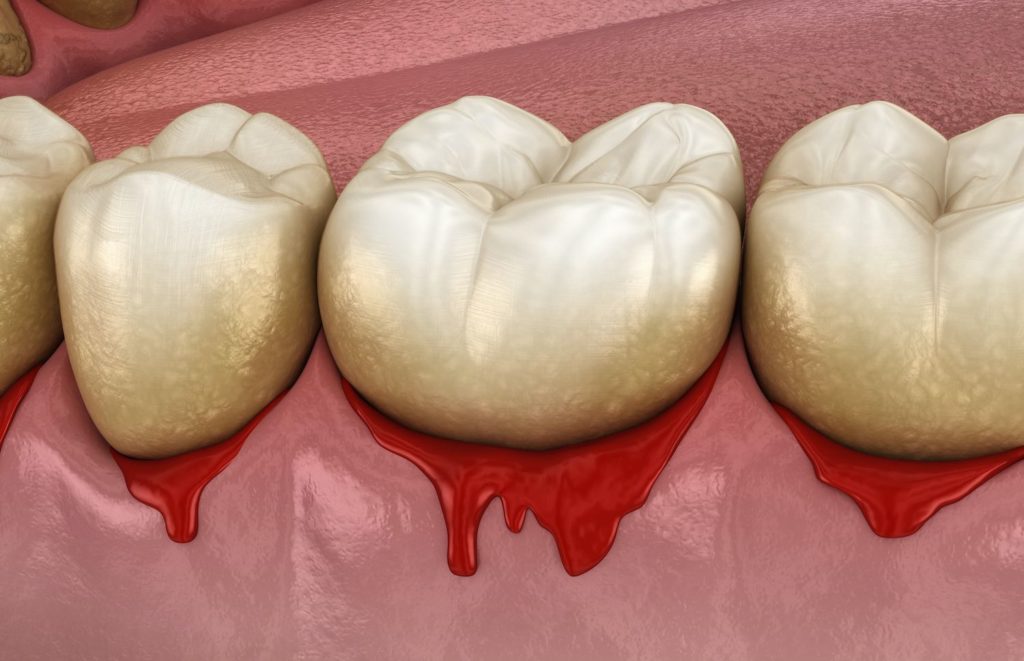Gum disease, or periodontitis, is an infection of the gums that can deteriorate the gums and advance to the jawbone. While that sounds terrible, gum disease is treatable and easily preventable.
Simple actions such as regular brushing and flossing can protect you from getting gum disease. However, if you are diagnosed with gum disease, there are several treatment options that vary from mild to severe.

What Does Gum Disease Look Like?
In its early stages, gum disease looks like swollen, red gums. You may even experience pain in your gums. Dentists call this stage of gum disease gingivitis.
Many people might develop gingivitis at some point in their life, but they may miss or misunderstand their symptoms. When gingivitis advances into periodontitis, it can cause much larger issues than bleeding gums.
The infection will start to attack the gums and create small pockets in between the teeth and the gums. This makes the connective tissue that roots the tooth to the gum vulnerable.
Over time, these pockets will deepen until it destroys the gums and bone, which will loosen the teeth. There will be no anchor for the tooth to continue to take root, so it will eventually fall out.
Some of the symptoms of gum disease are mild enough to go unnoticed. Symptoms— such as bad breath, swollen or red gums, or bleeding after brushing your teeth—may occur due to something unrelated to gum disease, making it difficult to fully draw the connection without seeing a doctor before it advances to tooth loss. Your gums should always be pink, and you shouldn’t experience pain or bleeding when brushing your teeth.
What Initial Treatment Can My Dentist Provide?
If the gum disease is not too advanced, there are some less invasive procedures that can reverse the effects of gum disease. Scaling is a type of deep cleaning that involves removing plaque and tartar from the teeth by using traditional tools or perhaps by using lasers or an ultrasonic device.
It may depend on the amount of plaque buildup you have on your teeth and along your gum line. In conjunction with scaling, a dental hygienist will also “root plane” your teeth, which is when they remove the rough and bumpy surfaces to minimize plaque buildup.
You may also receive antibiotics in order to fight off infection. You can take these antibiotics in a variety of methods, including orally and topically. Much like a small injury outside your mouth, you would put on an antibiotic ointment to avoid bacterial infection.
Antibiotics for gum disease work in the same way. Your dentist may give you either a topical ointment to place directly on your gums, or you may get an antibiotic mouthwash to swish in between your teeth. To completely eliminate all signs and effects of infection, you may also need to take oral antibiotics.
How Do Dentists Treat Advanced Gum Disease?
More advanced gum disease requires more advanced, more invasive surgical procedures. If the plaque and tartar buildup is beyond the scope of routine scaling, you may need flap surgery. Flap surgery is where part of the gum tissue is surgically lifted in order to completely scale and plane your teeth.
If your gum disease deteriorates portions of your gums or bone, you may need a graft. A gum graft will take a small portion of the roof of your mouth (or another site) and attach it to the affected area, which should reduce the recession of your gums. A bone graft is where your dentist will take a small portion of bone and attach it to your jaw to prevent tooth loss.
Gum disease is preventable, but it is also treatable. The best method to avoid painful and costly procedures is to use preventative measures with good oral health.
